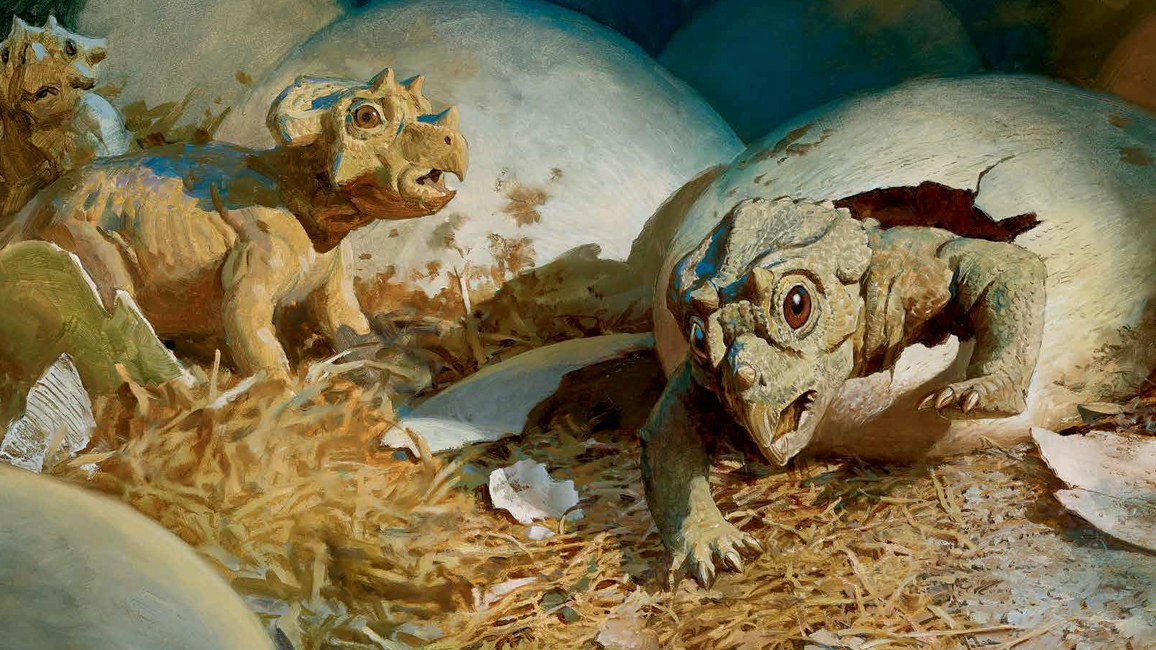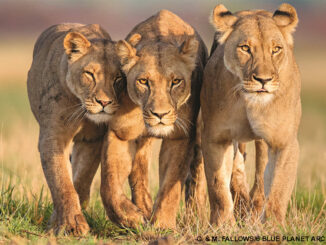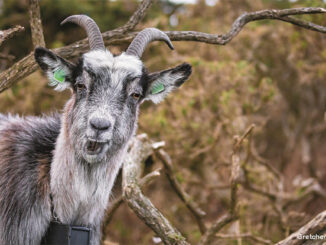
Dinosaur Babies
By Kathy Kranking; art by James GurneyFor a long time, nobody knew where baby dinosaurs came from. But now we know that dinosaurs hatched from eggs.
Fossil dinosaur eggs have been found in places all around the world! (Fossils are the preserved remains of ancient living things.)
Dino eggs come in two basic shapes: round and oval. Different kinds of dinosaurs laid their eggs in different patterns, such as in a spiral or in rows. But they always laid their eggs in nests. Some dinos scooped out nests on the ground. Others built raised nests of mud. Some of the nests were really big—a person could lie down across one with room to spare!
The only way for scientists to know for sure what kind of dinosaur laid an egg is to find a baby dinosaur inside. That’s hard to do—usually the remains of baby dinosaurs either aren’t preserved or are just crushed jumbles of bones. But scientists have found fossils of babies. The most famous discovery was in the 1990s: a very well-preserved baby dino in an egg! The baby was lying in the same position it would have been when it was alive. Scientists named it Baby Louie. They believe it was a type of bird-like dinosaur called an Oviraptor (OH-vuh-rap-tur.) Studying the fossils of eggs, nests, and babies can give scientists clues about how dinosaurs lived and grew up.
GOOD PARENTS
After studying the fossils they have collected over the years, some scientists now believe that some kinds of dinosaurs might have cared for their young. For example, huge nesting grounds of the duck-billed dinosaur Maiasaura (my-uh-SOR-uh) have been discovered—some of them with more than 40 nests! In the nests were the bones of babies, and near the nests were the bones of adults. Since the bones were found together, this could show that the adults cared for their babies.
By studying the leg bones of some dinosaur babies, scientists have learned that they probably weren’t strong enough for the babies to be able to walk yet. Scientists have even discovered fossils of what seem to be chewed-up plant bits in the nests, which could show that the adults fed their babies.
BONY BLUNDER
Scientists have also found fossils of Oviraptor dinosaurs actually sitting on their nests to brood their eggs! When the first of these fossils was discovered, scientists mistakenly thought the eggs were those of a different kind of dinosaur than the adult dinosaur on top of them. They thought the dino was stealing the eggs, so they gave it the name, Oviraptor, which means “egg thief.”
Later, another nest of eggs was uncovered with an Oviraptor on top of it. This time, parts of a baby dinosaur were inside one of the eggs. The baby turned out to be an Oviraptor, too. Since then, other Oviraptor fossils have been found on their nests as well. So although the name stuck, Oviraptor wasn’t really an egg thief at all—just a good parent taking care of its eggs.
STAYING ALIVE
Like most animals, baby dinosaurs faced dangers. Many types of dinosaurs and other animals probably preyed on dino eggs and young. Some dinosaurs laid a large number of eggs—20 or more in some cases. Maybe this was so that, even if some were eaten by hungry enemies, there were still good chances of the others surviving.
Several years ago, scientists discovered the fossil of a giant snake in a nest of baby sauropod (SOR-uh-pod) dinosaurs. This could have shown that the snake was feeding on the babies. Also, some fossil eggs seem to have the shells caved in, which could have been caused by a predator attacking the eggs.
Dino parents may have tried to protect their babies from attacking predators. And some dinosaurs may have lived in large herds, which could have been for safety. Fossils of trackways showing footprints of both adults and youngsters have been found. These might show that the babies stayed with the adults as they got older so that the adults could continue protecting them.
LOOKING FOR ANSWERS
To try to figure out what baby dinosaurs’ lives were like, scientists look at dinosaur relatives that are living today: crocodiles and birds. For example, some crocodiles, unlike most reptiles, guard their nests and even watch over their young. And here’s another similarity to crocodiles: While dinosaurs that didn’t get very big could sit on their nests to keep them warm, more gigantic dinos couldn’t do that without crushing their eggs. These dinos may have covered their eggs with plants to keep them warm, just as many crocodiles and some birds do.
Dinosaurs have even more similarities to birds, which most scientists now consider to be “living dinosaurs.” Scientists can make guesses that at least some dinosaurs may have behaved much as birds do, feeding and caring for their helpless babies.
On the other hand, some baby birds, such as geese and ducks, are able to walk and leave the nest shortly after hatching. The bones of baby Troodon (TROH-uh-don) dinosaurs show that they, too, may have been strong enough to leave the nest right away.
Another similarity is that birds such as flamingos and pelicans nest in large groups, just as the Maiasauradinosaurs seem to have done.
CLUES IN THE ROCKS
As you can probably guess, piecing together the stories of dinosaurs’ lives from fossils that are millions of years old isn’t easy. But the more fossil clues we can find, the more we can learn about baby dinosaurs. The answers are out there, buried in the rocks, just waiting to be discovered.
“Dinosaurs Were Babies, Too!” originally appeared in the May 2014 issue of Ranger Rick magazine.
(Click on each image above for a closer view of the story.)



















